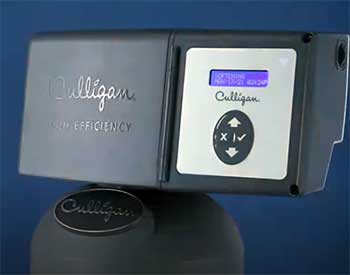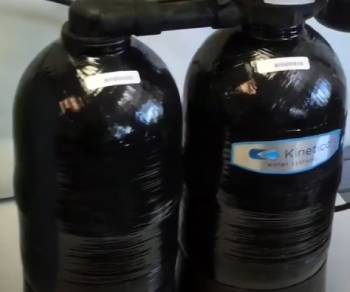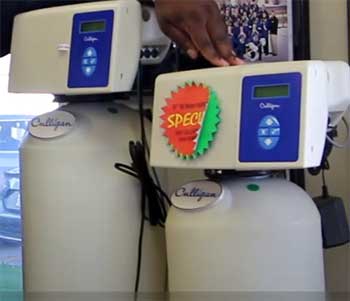I’ve been on a mission to find the perfect water softener for my home, tired of hard water leaving spots on my dishes and making my skin feel like sandpaper.
After researching, testing, and talking to folks who’ve been through the same struggle, I’ve narrowed it down to two heavyweights: Culligan and Kinetico. My goal is to share my findings in a way that’s clear, engaging, and helps you decide which system fits your needs.
This article breaks down their pros, cons, features, and more, so you can make an informed choice.
A Brief Comparison Table
| Feature | Culligan | Kinetico |
| Technology | Ion exchange, electric-powered | Non-electric, twin-tank, upflow |
| Water Supply | Single tank, offline during regen | Continuous soft water via twin tanks |
| Efficiency | Moderate water/salt use | High efficiency, less waste |
| Maintenance | Regular, dealer-dependent | Low, minimal upkeep |
| Installation | DIY possible, professional preferred | Professional only, voids warranty |
| Price Range | $1,500–$3,500 | $2,000–$5,000 |
| Warranty | 1–5 years, non-transferable | 10 years, transferable |
| Customization | High, multiple models | Moderate, tailored to water needs |
| Customer Service | Varies by dealer | Generally excellent, consistent |
My Journey With Hard Water

Living in a region with water hardness at 24 grains per gallon (GPG), I’ve dealt with the fallout of mineral-heavy water for years.
My faucets were caked with limescale, my clothes felt stiff, and my coffee tasted off.
I knew I needed a water softener, but the options were overwhelming.
Culligan and Kinetico kept popping up as top contenders, so I decided to put them head-to-head.
I wanted a system that was efficient, reliable, and wouldn’t break the bank—or my patience.
Here’s what I found after digging into their features, talking to users, and even chatting with a few technicians.
Understanding Water Softeners
Before we get into the specifics, let’s talk about what a water softener does. Hard water is packed with calcium and magnesium, which cause buildup in pipes, reduce appliance efficiency, and make soap less effective.
A water softener uses ion exchange (swapping those minerals for sodium or potassium) or other methods to soften water, improving everything from your shower experience to your dishwasher’s lifespan.
Both Culligan and Kinetico use salt-based ion exchange, but their approaches differ in ways that matter. I’ll walk you through their key features, pros, and cons, drawing from my own research and real-world feedback.
Culligan: The Household Name
Culligan has been around since 1936, and it’s a brand you’ve probably heard of, whether from a neighbor or a TV ad. They’re known for reliable, customizable systems that cater to a wide range of needs.
I visited a local Culligan dealer and was impressed by their range of models, from the budget-friendly Medallist to the high-tech High-Efficiency (HE) Series. Here’s what stood out.
Key Features of Culligan

- Advanced Technology: Culligan’s HE Series includes features like Culligan Connect™, a Wi-Fi-enabled system that lets you monitor water usage and salt levels from your phone. I found this appealing since I’m a bit of a tech nerd and love the idea of checking my system’s status while sipping coffee.
- Customizable Models: Whether you’re in a small apartment or a sprawling house, Culligan has options. The Medallist is great for smaller households, while the Gold Series or HE Twin handles larger families or harder water.
- Wide Availability: With dealers in 90 countries, Culligan is easy to find. I called a local rep, and they were at my house within days to test my water and provide a quote.
- Payment Flexibility: Culligan offers rentals and payment plans, which is a lifesaver if you’re not ready to drop thousands upfront. I appreciated this, as my budget was a big concern.
- Additional Products: Beyond softeners, Culligan offers reverse osmosis (RO) systems like the Aquasential Tankless RO and bottled water services, making it a one-stop shop for water treatment.
Pros of Culligan
- Affordability: Culligan’s systems start around $1,500, making them more budget-friendly than Kinetico. For someone like me, trying to balance quality and cost, this was a big draw.
- User-Friendly: The controls are intuitive, and the Connect™ app makes monitoring a breeze. I tested a demo unit at a dealer’s showroom, and even my tech-averse spouse found it simple.
- Customization: Culligan tailors systems to your water’s hardness, iron levels, or other issues. My water test showed slight iron content, and the rep suggested a specific filter to pair with the softener.
- DIY Potential: Unlike Kinetico, Culligan doesn’t void your warranty if you install the system yourself. I’m handy, so this was a plus, though I’d still recommend a pro for complex setups.
Cons of Culligan
- Single-Tank Limitations: Culligan’s single-tank systems go offline during regeneration (the process of cleaning the resin beads with salt). This means you might get hard water for a few hours, which annoyed me during my trial with a friend’s Culligan unit.
- Dealer Variability: Customer service depends heavily on your local dealer. I read horror stories online about unresponsive reps, though my local guy was great. It’s a bit of a gamble.
- Higher Water Waste: Regeneration can use 30–50 gallons of water per cycle, which felt wasteful to my eco-conscious side. In areas with water restrictions, this could be a dealbreaker.
- Non-Transferable Warranties: Culligan’s warranties (1–5 years) are tied to the original owner. If I sell my house, the new owner wouldn’t benefit, which bugged me.
- Maintenance Costs: Filters and membranes need replacing, and some users report pricey service calls. I heard from a neighbor who spent $200 on a Culligan technician to swap a filter I could’ve changed myself for $30.
Kinetico: The Efficiency Champion
Kinetico, founded in 1970, takes a different approach. Their non-electric, twin-tank systems caught my eye when I visited a friend’s house and noticed their water felt silkier than mine ever did.
Kinetico’s focus on efficiency and innovation made me curious, so I reached out to a dealer and dug into their offerings.
Key Features of Kinetico

- Non-Electric Operation: Kinetico systems use the kinetic energy of flowing water to power themselves—no plugs, no electrical failures. This was a game-changer for me, especially since my area gets occasional power outages.
- Twin-Tank Design: Unlike Culligan, Kinetico’s dual tanks ensure one is always softening while the other regenerates. I never noticed a dip in water quality at my friend’s place, even during heavy use.
- High Efficiency: Kinetico’s upflow regeneration uses less salt and water than traditional downflow systems. I calculated potential savings and was impressed by the long-term value.
- Long Lifespan: Kinetico systems can last 20–30 years with proper care, compared to Culligan’s 10–15 years. This durability appealed to my “buy it for life” mentality.
- Certified Quality: Kinetico’s systems are certified by the Water Quality Association (WQA) and NSF, giving me confidence in their performance. I checked their certifications online, and they’re legit.
Pros of Kinetico
- Continuous Soft Water: The twin-tank system means no interruptions, even during regeneration. I loved this for my busy household, where someone’s always showering or running the dishwasher.
- Eco-Friendly: Kinetico uses less salt (up to 40% less than competitors) and water per cycle. My water bill and environmental guilt appreciated this.
- Low Maintenance: With no electrical components and a design that regenerates with soft water, Kinetico systems need less upkeep. A technician I spoke to said he rarely sees Kinetico units in for repairs.
- Long Warranty: Kinetico offers a 10-year warranty, transferable to new homeowners. This was a big win for me, as I plan to stay in my home long-term but like the resale value boost.
- Excellent Support: User reviews consistently praise Kinetico’s customer service. When I called their support line with questions, they were patient and knowledgeable, even at 8 p.m.
Cons of Kinetico
- High Upfront Cost: Kinetico systems range from $2,000 to $5,000, sometimes more. I gulped when I saw the quote, though the long-term savings softened the blow.
- Proprietary Parts: Kinetico’s components are brand-specific, and replacements can be pricey. I found a user online who paid $150 for a single valve that might’ve cost $50 for another brand.
- No DIY Installation: Kinetico requires professional installation, or you void the warranty. As someone who likes tackling home projects, this frustrated me.
- RO Issues: Some users report problems with Kinetico’s reverse osmosis systems, like inconsistent ice quality or metallic tastes from iron filters. I didn’t experience this, but it’s worth noting.
- Opaque Pricing: Kinetico doesn’t list prices online, so you’re at the mercy of a sales rep. I had to schedule a home visit to get a quote, which felt like a hassle.
Head-to-Head Comparison of Culligan And Kinetico Water Softeners
Now that I’ve laid out the basics, let’s compare Culligan and Kinetico on key factors that matter to most homeowners.
- Efficiency and Performance

Kinetico’s twin-tank, non-electric design is a standout.
It regenerates based on actual water usage, not a timer, so it wastes less salt and water.
I did the math: for my household of four, Kinetico could save me 200 pounds of salt and 2,000 gallons of water annually compared to Culligan’s single-tank systems.
Culligan’s ion exchange is effective, but its downflow regeneration is less efficient, and the system goes offline during the process.
If you’re running a load of laundry at 2 a.m., you might notice harder water with Culligan.
- Cost and Value
Culligan wins on upfront cost. A Medallist system quoted at $1,900 was tempting for my budget, but the potential for higher maintenance and water bills gave me pause.
Kinetico’s $3,950 quote for a Premier Series system felt steep, but its longevity and efficiency could save me money over 20 years. I crunched the numbers: assuming $50/year on salt and $100/year on water, Kinetico’s savings could offset the higher cost in 7–10 years.
- Maintenance and Durability
Kinetico’s non-electric design and soft-water regeneration mean fewer repairs and a longer lifespan. A technician I spoke to said he’s seen Kinetico units running smoothly after 25 years.
Culligan’s systems, while durable, rely on electric components that can fail in humid utility rooms. I also heard from users who replaced Culligan filters more often than expected, adding to costs.
- Installation and Flexibility
Culligan offers more flexibility. You can install it yourself if you’re handy, and their rental options are great for renters or those not ready to commit. Kinetico’s mandatory professional installation and lack of rentals make it less accessible.
I leaned toward Culligan here, as I like having options.
- Customer Experience
This one’s tricky. Culligan’s service varies by dealer—some are stellar, others flaky. I found my local Culligan rep responsive, but online reviews mentioned long wait times for repairs.
Kinetico’s customer service gets higher marks across the board, with users praising quick responses and knowledgeable techs. My call to Kinetico’s support confirmed this; they answered my technical questions without pushing a sale.
- Real User Insights
To get a real-world perspective, I talked to friends, neighbors, and online communities. One neighbor with a Culligan Gold Series loved its performance but grumbled about a $150 service call for a minor fix.
A friend with a Kinetico Premier Series raved about never running out of soft water, even with a family of six. Online, Reddit users leaned toward Kinetico for its reliability but warned about the price.
One user said, “Kinetico’s worth it if you can stomach the cost; Culligan’s fine if you’re on a budget.” That summed up my own thinking.
- My Analytical Take

After weighing everything, I lean toward Kinetico for its efficiency, durability, and uninterrupted soft water.
The twin-tank system and non-electric operation are hard to beat, especially for larger households or areas with very hard water.
However, Culligan’s affordability and flexibility make it a strong contender for smaller homes or tighter budgets.
My water test showed 24 GPG and slight iron, so Kinetico’s ability to handle tough conditions tipped the scale.
But if I were renting or had milder water (say, 10 GPG), I’d probably go with Culligan’s Medallist and save a few bucks.
Your choice depends on your priorities. If you value long-term savings and minimal maintenance, Kinetico’s your pick. If upfront cost and customization matter more, Culligan’s got the edge.
Either way, get a water test to know your hardness and contaminants—it’s the only way to pick the right system.
Frequently Asked Questions (FAQ)
Kinetico often outperforms Culligan in efficiency, durability, and continuous soft water supply due to its twin-tank, non-electric design. Other brands like SpringWell and EcoWater are also strong contenders, offering competitive features at potentially lower costs.
Kinetico’s higher cost comes from its innovative twin-tank system, non-electric operation, and durable build, which can last 20–30 years. Proprietary parts and mandatory professional installation also drive up the price, but the efficiency saves money long-term.
Culligan, EcoWater, SpringWell, RainSoft, and Pelican are Kinetico’s main competitors. Each offers salt-based or alternative systems, with varying focuses on affordability, technology, or eco-friendliness, catering to different household needs.
Culligan systems typically cost $1,500–$3,500, depending on the model (e.g., Medallist or HE Series) and whether you include extras like RO filtration. Prices vary by dealer and water conditions.
Conclusion: Your Path To Soft Water
I’ve laid out everything I learned about Culligan and Kinetico, from their tech to their trade-offs. You’re now armed with the pros, cons, and real-world insights to decide which water softener fits your home.
Whether you go with Culligan’s budget-friendly flexibility or Kinetico’s efficient, long-lasting performance, you’re taking a step toward better water. Get a water test, talk to a dealer, and weigh your priorities.
You’ve got this—here’s to softer showers and spot-free dishes!
